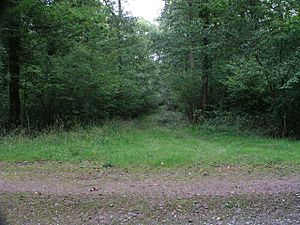Chiddingfold Forest facts for kids
| Site of Special Scientific Interest | |
 |
|
| Area of Search | Surrey West Sussex |
|---|---|
| Interest | Biological |
| Area | 542.5 hectares (1,341 acres) |
| Notification | 1991 |
| Location map | Magic Map |
Chiddingfold Forest is a very special natural area located across parts of Surrey and West Sussex in England. It covers about 542.5 hectares, which is roughly the size of 800 football fields! This area is so important for nature that it has been named a Site of Special Scientific Interest (SSSI). This means it's legally protected because of its rare plants, animals, or unique geology.
One part of Chiddingfold Forest, called Fir Tree Copse, is a nature reserve. It is looked after by the Surrey Wildlife Trust, an organization that works to protect wildlife and wild places.
Contents
What Makes Chiddingfold Forest Special?
Chiddingfold Forest isn't just one big block of trees. It's made up of several different areas, each with its own mix of natural spaces. This mix is called a "mosaic of habitats." Think of it like a patchwork quilt, where each patch is a different type of environment.
Different Habitats
The forest includes a variety of habitats that provide homes for many different creatures:
- Ancient Woodland: These are woodlands that have been around for a very long time, sometimes for hundreds of years. They are rich in biodiversity and have unique plants and fungi that can't be found easily elsewhere.
- Conifer Plantations: These are areas where trees like pines and spruces have been planted. While they might look different from ancient woodlands, they still provide important shelter and food for certain animals.
Amazing Insects
Chiddingfold Forest is especially famous for its incredible insect life. Over 500 different types of butterflies and moths have been found here! This huge number shows how healthy and diverse the forest's environment is.
Some of the insects found here are very rare and even endangered. This means they are at risk of disappearing forever if their habitats aren't protected.
Rare Butterflies and Moths
- Wood White Butterfly: This delicate white butterfly is quite rare in the UK. It needs specific types of plants to lay its eggs on, which are found in places like Chiddingfold Forest.
- Rest Harrow Moth (Aplasta ononaria): This small, pretty moth is also very uncommon. Its caterpillars feed on a plant called rest harrow, which grows in certain open areas of the forest.
- Orange Upperwing Moth (Jodia croceago): As its name suggests, this moth has distinctive orange upper wings. It's another rare species that finds a safe home in the forest.
Other Unique Insects
Besides butterflies and moths, other interesting insects live here. For example, the Cheilosia carbonaria hoverfly has also been recorded. Hoverflies are important pollinators, helping plants to reproduce.
Why is Chiddingfold Forest Protected?
Chiddingfold Forest was officially designated as a Site of Special Scientific Interest in 1991. This protection is vital because it helps to:
- Protect Rare Species: It ensures that the rare butterflies, moths, and other creatures have a safe place to live and thrive.
- Preserve Habitats: It helps to keep the ancient woodlands and other habitats healthy and undisturbed.
- Support Biodiversity: By protecting this area, we help to maintain the variety of life on Earth, which is important for our planet's health.
Looking after places like Chiddingfold Forest helps us understand and appreciate the natural world around us. It also ensures that these special places can be enjoyed by future generations.

